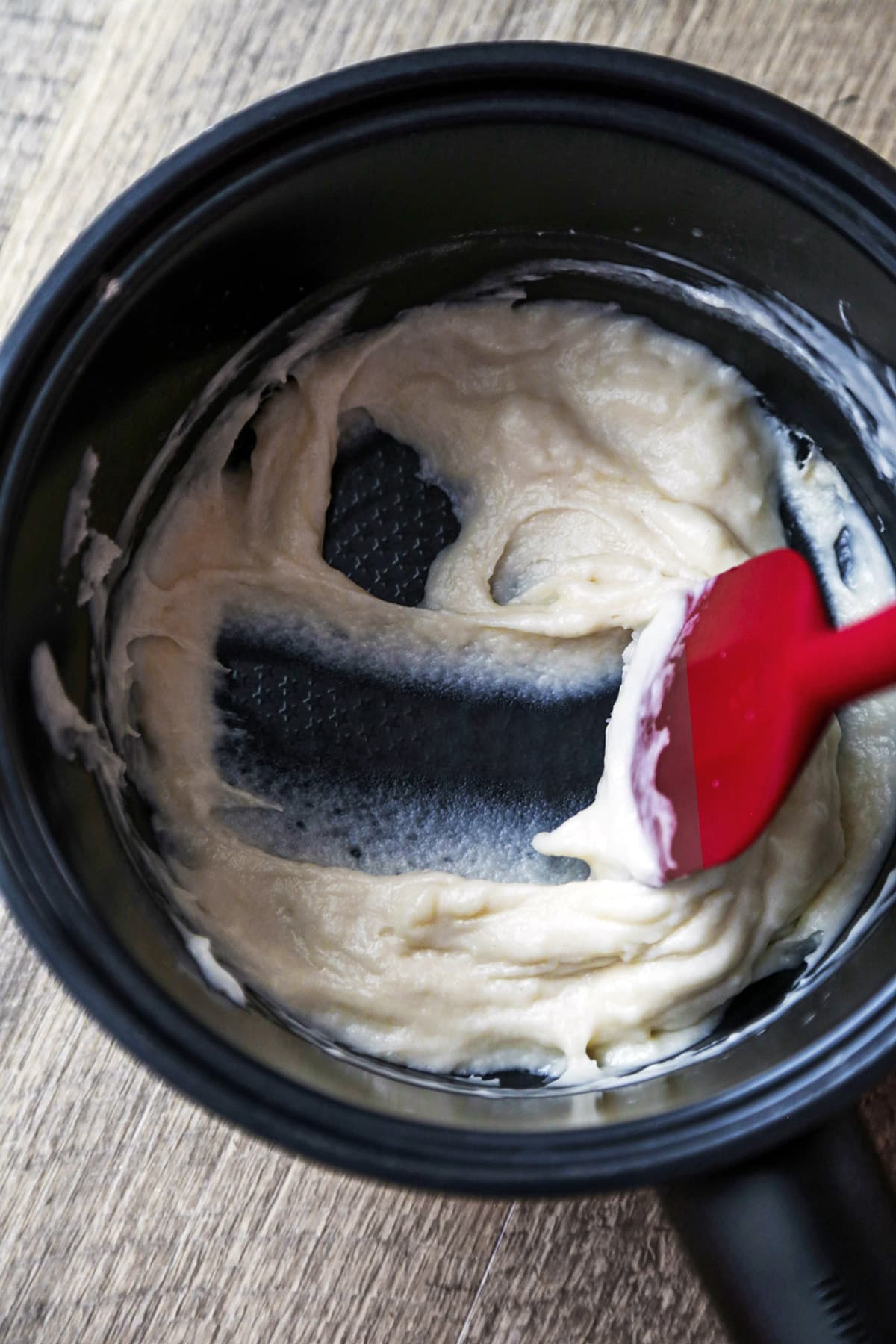Every time I go to Japan I get giddy about Japanese bakeries! And though I love almost all of their different flavors and fillings, my favorite one is the classic Japanese milk bread, because it’s so soft, airy, and buttery..

Japanese milk bread is strongly linked to my childhood as my aunt made it from scratch almost daily. I would wake up with the smell of fresh bread wafting through the kitchen. She would cut me a thick slice – because shokupan is better when it’s cut thick – toast it, and spread a generous amount of butter and strawberry jam on it.
It was the best breakfast ever.
You may not know this but when it comes to making outstanding bread, Japanese bakeries are on par with the French ones.
Bakeries are abound in Japan and can be found on almost every street, in the basement of department stores, train stations, even subway platforms. Bread is huge in Japan and because the options are endless – from deep fried curry bread, bun stuffed with red bean paste, to cheese and corn baguette – it’s impossible to get bored!
While shokupan is easy to find in big cities such as L.A, Honolulu, Chicago, and NYC, it’s more of challenge to find it in areas where there are few Japanese people. And since we left NYC for the midwest just over a year ago (a temporary move to be closer to an ailing parent), I’ve been craving Japanese milk bread almost daily.
So what’s a girl to do when she can’t find her favorite bread? She learns how to make it!
There are quite a few steps to this recipe but they are all very easy to follow.
It took me a few attempts before I was satisfied with the taste and texture of my milk loaf, but I can now say that I’m very happy with it. I’m also super excited to share it with you!

What is Japanese Milk Bread (Shokupan)?
Japanese milk bread (食パン) is Japan’s version of sandwich bread. The word shokupan simply means “eating bread”.
The main difference between the sandwich bread you are used to eating and Japanese milk bread is the use of yudane, a starter paste (roux) made with an equal amount of flour and boiling water. The paste retains its moisture and makes the dough soft, airy, and stretchy.
What is Tangzhong?
Tangzhong is also a starter paste used to make bread.
It was adapted from the yudane method by a Taiwanese woman name Yvonne Chen. Tangzhong is made by stirring flour and water, or milk, together and cooking it until the mixture becomes a gelatinous paste. Tangzhong is most often used to make Chinese buns and can also be used to make Japanese milk bread.
We will be using tangzhong to make this milk bread.

Where to Buy Japanese Milk Bread
If you are lucky enough to be living close to a Japanese supermarket, you won’t have any issue finding shokupan. Korean bakeries also sell it and you may even find it in some Asian grocery stores. But the best shokupan I’ve had outside of Japan were sold in Japanese bakeries.
Places like Takahachi Bakery in Tribeca, Yamazaki Bakery in Los Angeles, and Hamada-ya in Torrance, sell some of the best Japanese milk bread I have tasted here in the US.
What Does it Taste Like?
Japanese milk bread is a little sweet and buttery. Every bakery has a different recipe – they may use more or less sugar, butter, and might use whole milk or 2% milk.
This means that every shokupan is slightly different than the other, but there should always be a little sweetness, and you should be able to smell the butter.
Just try it. It’s amazing.

Kitchen Tools Needed
- Stand mixer
- Bowl
- Rolling pin
- 9-by-5-inch loaf pan
Best Flour for Japanese Milk Bread
While you technically can use all-purpose flour to make shokupan, I recommend using bread flour that’s over 12% protein to get the most rise. I have used bread flour that’s 9-10% protein but found my bread not to be as fluffy and airy.
King Arthur Unbleached Flour, which contains 12.7% protein, is the flour I used to make the milk loaf you see in these pictures.

Ingredients for Japanese Milk Bread (Shokupan)
- Starter (tangzhong): A mixture of bread flour, water, and milk. Tangzhon is what makes the bread super moist and fluffy.
- Flour: You can use all-purpose flour but to get a nice rise, use bread flour that’s at least 12% protein.
- Sugar: I don’t like my bread to be too sweet so I’ve only added 20 grams of sugar. However, feel free to add 30 or 40 grams for a sweeter, more dessert-like bread.
- Active dry yeast: 1 packet, which comes to 7 grams is what you will need to give your loaf a nice rise.
- Salt: Just a little to season the bread and balance out the sweetness.
- Egg: I’ve made shokupan with and without egg, and and both recipes were delicious. However, I noticed that the one with the egg was slightly more moist which is why I decided to add it to this recipe.
- Milk: Whole milk is often used to make Japanese milk bread, but I personally prefer using 2% milk or unsweetened oat milk.
- Butter: Use unsalted butter or unsalted vegan butter such as Miyokos.

How to Make Japanese Milk Bread (Shokupan)
- Make the tangzhong by mixing the starter ingredients in a pot. Cook on low heat while stirring constantly, for 8-10 minutes. The mixture is ready when it turns into a gelatinous paste.
- Turn the heat off and transfer the tangzhong to a bowl. Cover the bowl with plastic wrap and leave for 30 minutes.
- Add the bread flour, sugar, yeast, and salt, to the bowl of your stand mixer, and stir well to combine.
- Place the dough hook on your mixer and add the egg, milk, and tangzhong. Knead on low speed for 5 minutes.
- Add the butter and knead on medium speed (4 on a Cuisinart stand mixer) for 20 minutes, until the dough is springy and sticky.
- Meanwhile, lightly grease a bowl with cooking spray, or brush with oil.
- Turn the mixer off, wet your hands or rub them with a little oil, and scoop the dough.
- Shape the dough into a ball and place it in the bowl. Cover with plastic wrap and let it rise for 50 minutes. It’s best to find a warm spot (75-85ºF) to help your dough rise to about double its size.
- Punch the dough a couple of times and transfer it to a flat surface. Equally cut the dough in half and shape the halves into balls (you may need to lightly wet or oil your hands again). Cover the balls with a kitchen towel, take them back to that warm spot, and leave to rise for 15 minutes.
- Grease a 9-by-5-inch loaf pan and set aside.
- Use a rolling pin to roll out each dough ball into a 6-by-9-inch oval.
- Fold each side of the oval and make them join in the center. Do the same with the top and bottom (bring them to the center).
- Tightly roll the dough into a log and place it on one end of the loaf pan, smooth side up. Repeat the same steps for the remaining ball and place it on the other end of the pan.
- Cover with plastic wrap (not too tightly) or a kitchen towel, and take the loaf pan to that warm spot. Leave for 40 minutes, until the logs have doubled in size and are touching in the middle.
- Meanwhile, preheat the oven to 350ºF.
- Brush the top of the logs with a little milk and bake in the oven for 35-40 minutes. The bread is ready when the internal temperature has reached 190ºF.
- Transfer the bread to a cooking rack and let cool for 1 hour before eating.


Best Way to Eat Japanese Milk Bread
Japanese milk bread is so moist and airy that it’s best eaten fresh, when it’s still a little warm, and with just a little butter. And don’t be afraid to cut thick slices since that’s the way it’s usually served in Japan!
After a couple of days, you can toast it and spread a little jam on top (I don’t use peanut butter because I end up crushing the fluffiness when I spread it). It also makes a really good sandwich bread for egg salad.
The best way to store shokupan is in a plastic bag or a container that is airtight, so it can retain its moisture. It should still be very moist after 3-4 days, if stored properly.


Did you like this Japanese Milk Bread Recipe? Are there changes you made that you would like to share? Share your tips and recommendations in the comments section below!
PrintJapanese Milk Bread (Shokupan – 食パン)
Learn how to make the most delicious, moist, and airy, Japanese Milk Bread. Fresh warm shokupan is so easy to make!
- Prep Time: 35 minutes
- Cook Time: 35 minutes
- Total Time: 70 minutes + 1 hour 45 minutes passive time
- Yield: 2 small loaves of bread 1x
- Category: Baked goods
- Method: Baking
- Cuisine: Japanese
- Diet: Vegetarian
Ingredients
Starter (Tangzhong)
- 1/4 cup bread flour
- 1/4 cup milk (for vegan: use unsweetened oat milk)
- 5 tablespoons water
DOUGH
- 325g bread flour
- 20 grams sugar
- 7 grams active dry yeast (1 packet)
- 4 grams salt
- 1 large egg (for vegan: mix 1 tablespoon ground flaxseed with 2 1/2 tablespoons water. Let sit for 15 minutes before using)
- 130 milliliters room temperature milk (for vegan: use unsweetened oat milk)
- 50 grams unsalted butter, room temperature and cut into cubes (for vegan: use vegan butter)
Instructions
- To make the starter (tangzhong), whisk the flour, milk, and water, in a pot until smooth, and turn the heat to low. Stir and cook for about 8-10 minutes, until the mixture thickens and becomes a gelatinous paste.
- Turn the heat off and transfer the tangzhong to a bowl. Cover the bowl with plastic wrap and let cool for 30 minutes. Simple tip for fluffier bread: let the tangzhong sit for an additional 1-2 hours if you have the time. This will yield an even fluffier texture.
- Use the bowl of your stand mixer and add the flour, sugar, yeast, and salt. Stir until the ingredients are well mixed.
- Add the egg, milk, and tangzhong, place the dough hook on the mixer, and knead on low speed for 5 minutes.
- Add the butter and knead on medium (speed 4 on a Cuisinart stand mixer) for an additional 20 minutes, until the dough is springy and slightly sticky.
- Meanwhile, lightly grease a bowl and set it aside.
- Lightly wet your hands, or rub a little oil on them, and scoop the dough. Shape it into a ball and place it in the greased bowl. Cover with plastic wrap and let the dough rise for 50 minutes somewhere a little warmer than room temperature (75-85ºF), until it doubles in size.
- Punch the dough down and transfer it onto a flat surface. Equally cut the dough in half and shape into 2 balls. Cover the balls with a kitchen towel and let them rise for 15 minutes.
- Grease a 9-by-5-inch loaf pan and set aside.
- Use a rolling pin to roll out each dough ball into a 6-by-9-inch oval.
- Fold each side of the oval and make them join in the center. Do the same with the top and bottom (bring them to the center).
- Tightly roll the dough into a log and place it on one end of the loaf pan, smooth side up. Repeat the same steps for the remaining ball of dough and place it in the other end of the pan.
- Cover with a towel and let the dough rise for 40 minutes, until it has doubled in size.
- Meanwhile, preheat the oven to 350ºF.
- The dough is ready when the logs are touching in the center and are at the same level, or slightly over, as the pan.
- Brush the top of the dough with a little milk.
- Bake for 35-40 minutes. If the bread is turning a golden brown too quickly, lightly cover the pan with foil. The bread is ready when it reaches an internal temperature of 190ºF.
- Take the pan out of the oven and transfer the bread to a cooling rack immediately.
- Let cool for at least an hour before eating.
Notes
Make it vegan: Skip the egg, switch milk for unsweetened oat milk, and butter for vegan butter such as Miyokos.
Tools Needed:
- Stand mixer
- 9×5 loaf pan
- Rolling pin
Nutrition
- Serving Size: 1 slice
- Calories: 155
- Sugar: 3.4g
- Sodium: 138mg
- Fat: 3.9g
- Saturated Fat: 2.2g
- Unsaturated Fat: 0.3g
- Trans Fat: 0g
- Carbohydrates: 25.3g
- Fiber: 0.9g
- Protein: 4.4g
- Cholesterol: 9.3mg
Keywords: sandwich bread, Hokkaido milk bread






















Is there a way to make it without the mixer? Will working the dough with one’s hands work?
Hi Ania! I’m sure you can make it using your hands but I’m not sure how much kneading is needed. If you are used to making bread that way, I think you could make it no problem 🙂
Hi! Can’t wait to make this as I absolutely love Japanese milk bread. Have you tried proofing the dough overnight so you can just bake in the AM and have fresh bread for breakfast?
Hi Sejin! I haven’t tried proofing the dough overnight but I’m sure it would make it even better! 🙂
Caroline – it’s me again.. 4th recipe of yours I’ve tried, and with great success! This bread came looking like your pics, soft and luscious.. saved and printed.. reminds us of the soft and squishy WonderBread we bought growing up.. they out of business now, maybe it was a regional thing, IDK? THANKS MUCH!
★★★★★
Thank you so much Steve! 🙂
I just pulled this out the oven 30 minutes ago and it tastes AMAZING!!! It tastes just like the bread I ate in Japanese bakeries, and now I can have it in the States! I have never been able to find bread this soft even in the Asian grocery stores, and I know I’ll be making this again!
That’s wonderful Shizu! I’m so happy, you just made my day!!
I totally agree that Japanese bakeries are right up there with the French ones. When I am in Japan I have my favorite bakery to hang out in. Always a great selection. Never disappoints. And of course the employees are always welcoming and friendly. Thank you for posting this. It’s a great bread. Gathering the ingredients!
★★★★★
Sounds and looks delicious !
Unfortunately… I’ll need to pass baking it.
Don’t own a stand mixer.
I bake a lot but decided in my age (early 80s) of life.. not to purchase one.
On the lookout for good Japanese Bakeries.
Planning to visit Hawaii in October
Hi Doug! You will find really good shokupan in Hawaii, they have amazing Japanese bakeries. Lucky you!